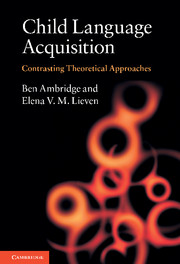Book contents
- Frontmatter
- Contents
- List of figures
- List of tables
- List of boxes
- List of summary tables
- Preface
- Acknowledgements
- 1 Introduction
- 2 Speech perception, segmentation and production
- 3 Learning word meanings
- 4 Theoretical approaches to grammar acquisition
- 5 Inflection
- 6 Simple syntax
- 7 Movement and complex syntax
- 8 Binding, quantification and control
- 9 Related debates and conclusions
- Notes
- References
- Author index
- Subject index
8 - Binding, quantification and control
Published online by Cambridge University Press: 05 June 2012
- Frontmatter
- Contents
- List of figures
- List of tables
- List of boxes
- List of summary tables
- Preface
- Acknowledgements
- 1 Introduction
- 2 Speech perception, segmentation and production
- 3 Learning word meanings
- 4 Theoretical approaches to grammar acquisition
- 5 Inflection
- 6 Simple syntax
- 7 Movement and complex syntax
- 8 Binding, quantification and control
- 9 Related debates and conclusions
- Notes
- References
- Author index
- Subject index
Summary
Up to this point, we have mainly been concerned with children's ability to produce and comprehend unambiguous sentences (e.g. The man kicked the ball; The boy who is smoking is crazy). In this chapter we investigate how children interpret sentences that are ambiguous, whilst ruling out non-adultlike interpretations, as in the examples below. Note the subscript notation used to show possible and impossible [*] interpretations (explained more fully below).
(a) Goldilocksi said that Mama Bearj is touching heri/*j (her = Goldilocks or somebody else, but not Mama Bear)
(b) Every dwarf ate a pizza (= Every dwarf ate a different pizza or Every dwarf ate the same pizza but not [necessarily] Every pizza was eaten by a dwarf)
(c) Johni told Billj [PRO*i/j] to leave (= Bill – not John – should leave)
(d) Johni promised Billj [PROi/*j] to leave (= John – not Bill – should leave)
In doing so, we will investigate the phenomena of binding (e.g. sentence (a) quantification (b) and control (c–d)).
For generativist accounts, all three phenomena require knowledge of the innately specified principle of c-command (Reinhart, 1983). Radford (2004: 75) defines c-command as follows:
A constituent X c-commands its sister constituent Y and any constituent Z which is contained within Y.
A simpler way to think about c-command is to use the analogy of a train network: X c-commands any node which one can reach by ‘taking a northbound train [from X], getting off at the first station, changing trains there and then travelling one or more stops south on a different line’ (Radford, 2004: 75).
- Type
- Chapter
- Information
- Child Language AcquisitionContrasting Theoretical Approaches, pp. 314 - 358Publisher: Cambridge University PressPrint publication year: 2011



